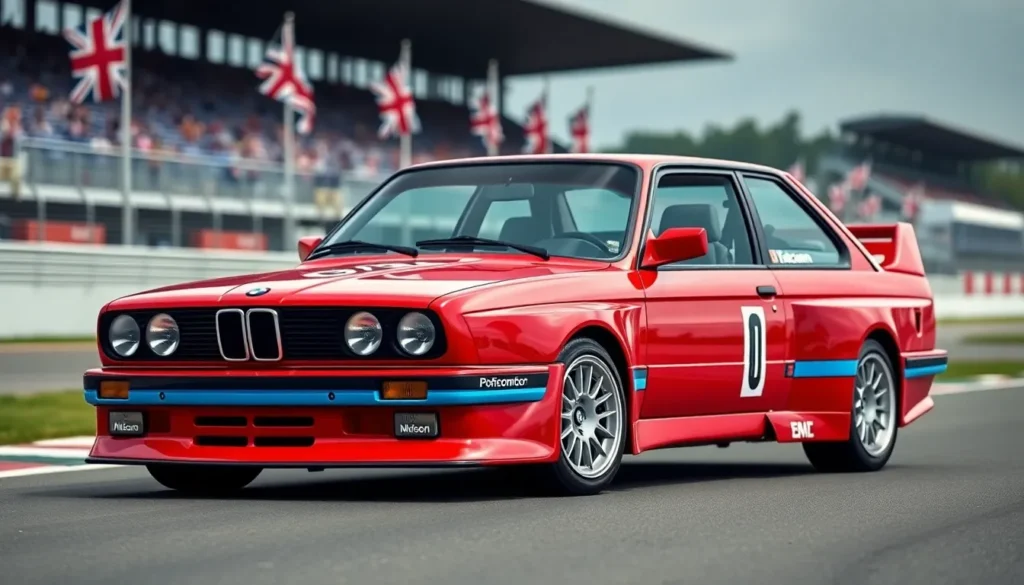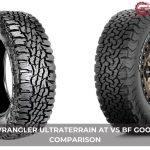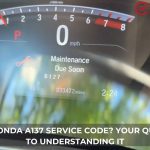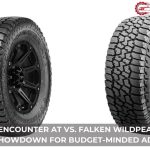The BMW E30 M3 stands as one of the most legendary performance cars ever created. We’re talking about a machine that perfectly blends racing pedigree with street-worthy practicality – something that’s incredibly rare in today’s automotive industry.
Born from BMW’s need to homologate their touring car racer, the E30 M3 wasn’t just another sports car. It was a purpose-built weapon designed to dominate racetracks around the industry. With its aggressive body kit, naturally aspirated S14 engine, and razor-sharp handling characteristics, this compact coupe redefined what a performance car could be.
Today, we’ll dive deep into why the E30 M3 continues to captivate enthusiasts decades after production ended. From its racing heritage to its investment potential, we’ll explore what makes this BMW so special and why it’s considered the holy grail of M cars.
BMW E30 M3 Overview and History
The BMW E30 M3 emerged as BMW’s most successful touring car homologation special, transforming from racing necessity into automotive legend. BMW Motorsport developed this iconic machine to compete in Deutsche Tourenwagen Meisterschaft (DTM) racing series during the 1980s.
Origins and Development
BMW Motorsport created the E30 M3 in 1985 specifically for Group A touring car racing regulations. Regulations required manufacturers to produce at least 5,000 road-going examples of their racing cars, leading BMW to develop the M3 as a homologation special based on the standard E30 3 Series platform.
Engineers at BMW’s M division extensively modified the E30 chassis to create the M3 variant. The development team widened the body by 60mm at the front and rear wheel arches to accommodate wider tires and racing-inspired suspension components. BMW fitted the M3 with a unique S14 engine, a naturally aspirated 2.3-liter four-cylinder unit derived from the M88 engine found in the BMW M1 supercar.
The S14 engine featured individual throttle bodies, a 10.5:1 compression ratio, and advanced engine management systems for its era. BMW engineers designed the engine to produce 195 horsepower in European specification while maintaining reliability for both track and street use. The development process included extensive wind tunnel testing to perfect the distinctive rear spoiler and front air dam configuration.
Production Timeline and Numbers
| Production Period | Market | Units Produced | Engine Output |
|---|---|---|---|
| 1986-1991 | Europe | 17,970 | 195 hp |
| 1988-1991 | North America | 5,115 | 192 hp |
| Total | Worldwide | 23,085 | 192-195 hp |
BMW launched E30 M3 production at the Regensburg plant in February 1986 for European markets. The company began North American deliveries in 1988 with modified specifications to meet local emissions and safety regulations. European models received the full 195 horsepower S14 engine while North American versions produced 192 horsepower due to emissions equipment.
Production reached its peak in 1989 when BMW manufactured 6,309 units globally. The company offered several special editions throughout the production run including the Evolution I (1987), Evolution II (1988), and Sport Evolution (1989-1990) variants. These limited editions featured increased power output, aerodynamic enhancements, and lightweight components for enhanced track performance.
BMW concluded E30 M3 production in April 1991 after manufacturing exactly 23,085 examples worldwide. The final production year saw only 786 units built as BMW prepared to launch the successor E36 M3 model for the 1992 model year.
Engine and Performance Specifications
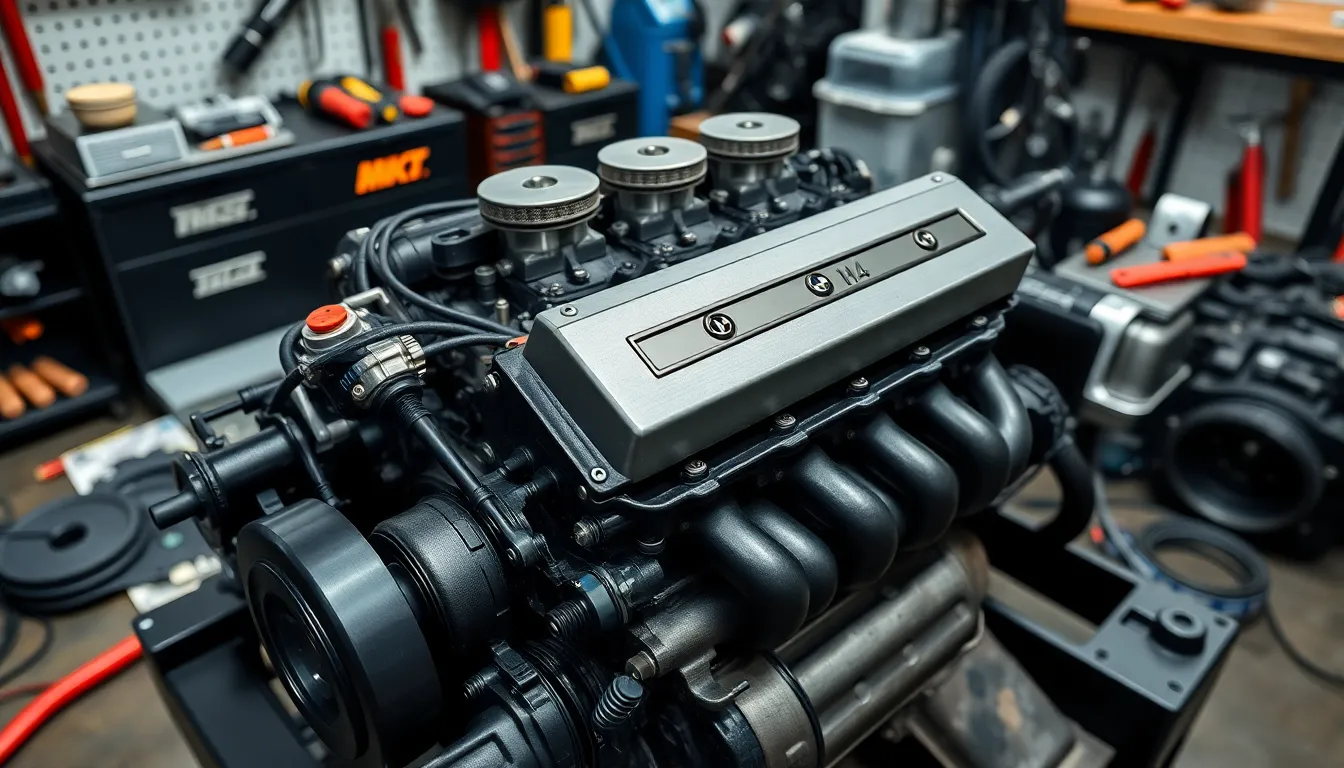
The E30 M3’s performance capabilities stem from its purpose-built powertrain architecture. BMW engineered every component to deliver track-ready performance while maintaining street usability.
S14 Four-Cylinder Engine
BMW’s S14 engine represents a masterpiece of naturally aspirated engineering designed specifically for the E30 M3. Engineers developed this 2.3-liter inline-four engine by combining the proven M10 engine block with a modified 16-valve cylinder head derived from the M88 six-cylinder powerplant found in the M1 supercar.
The S14 features dual overhead camshafts operating four valves per cylinder through individual throttle butterflies for each cylinder. This configuration delivers exceptional throttle response and power delivery characteristics that remain unmatched in modern turbocharged applications. Cast iron construction provides durability for high-revving operation up to 7,000 RPM redline.
European market engines produce maximum power at 6,750 RPM with peak torque delivery occurring at 4,750 RPM. North American versions received slightly different tuning to meet emissions requirements while maintaining the engine’s fundamental performance character.
Power Output and Acceleration
Power specifications vary between market regions due to different emissions regulations and tuning approaches. European E30 M3 models generate 195 horsepower and 170 lb-ft of torque from the S14 engine configuration.
| Market Region | Horsepower | Torque | 0-60 mph | Top Speed |
|---|---|---|---|---|
| European | 195 hp | 170 lb-ft | 6.7 seconds | 146 mph |
| North American | 192 hp | 170 lb-ft | 6.9 seconds | 140 mph |
North American models produce 192 horsepower due to catalytic converter requirements and different engine management calibration. Both versions deliver identical torque output of 170 lb-ft even though the power difference.
Acceleration performance places the E30 M3 among the quickest cars of its era. Quarter-mile times consistently measure 15.1 seconds at 91 mph trap speeds under optimal conditions. The naturally aspirated engine characteristics provide linear power delivery throughout the rev range without turbo lag interruptions.
Transmission Options
BMW offered exclusively manual transmission options for the E30 M3 to preserve the car’s sporting character and driver engagement. The standard transmission consists of a Getrag 265 five-speed manual gearbox specifically calibrated for the S14 engine’s power band.
Gear ratios optimize acceleration performance while providing reasonable highway cruising capability. First gear enables aggressive launches from standstill while fifth gear allows sustained high-speed driving without excessive engine RPM. The transmission features synchronized operation across all forward gears with a dogleg first gear pattern that places second gear in the upper left position.
Limited slip differential comes standard on all E30 M3 models with a 25% lock-up rate under acceleration and deceleration. This differential configuration improves traction during spirited driving while remaining manageable for everyday use conditions.
Design and Styling Features
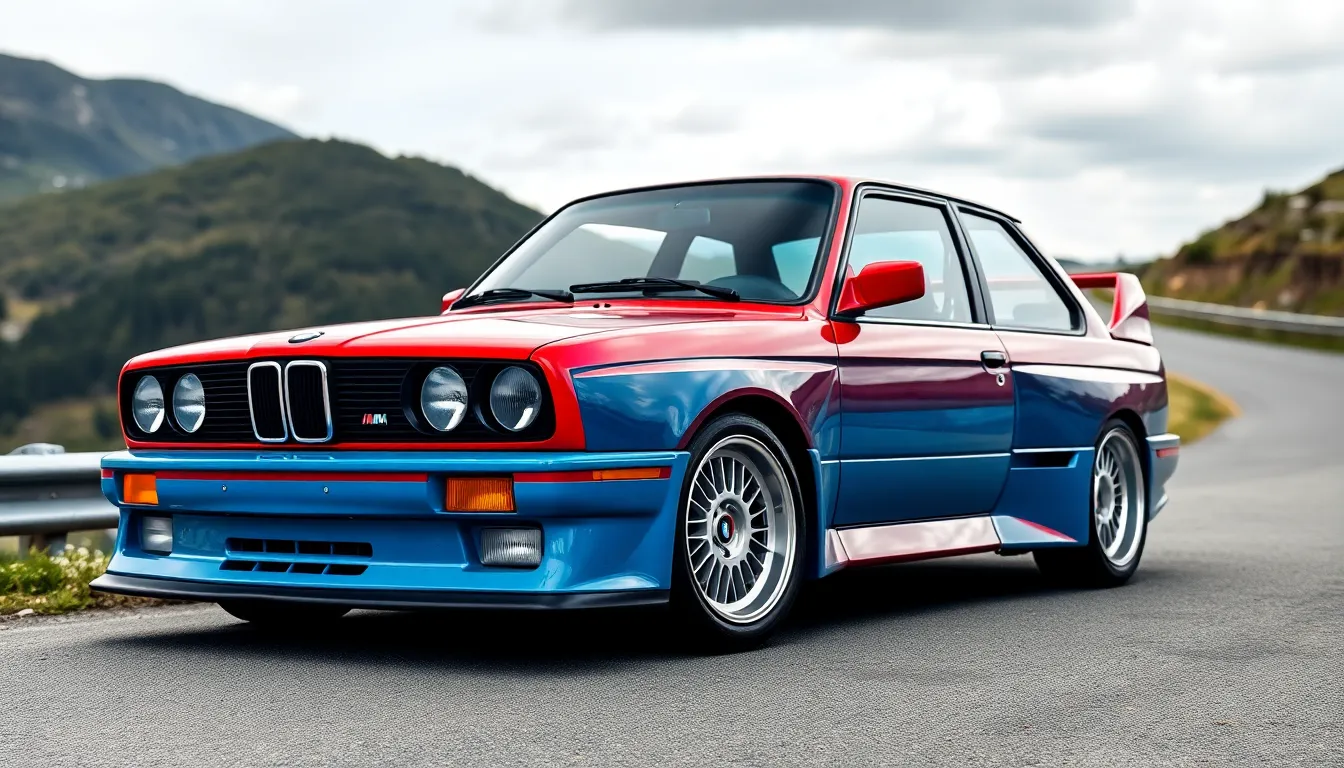
The BMW E30 M3’s design represents a perfect fusion of racing functionality and street presence. Every visual element serves a purpose while creating one of motorsport’s most iconic silhouettes.
Exterior Characteristics
We can identify the E30 M3 instantly by its distinctive widebody design that sets it apart from standard E30 models. The front bumper features an aggressive lower spoiler with integrated air intakes that channel cooling air to the brakes and engine bay. BMW engineers extended the wheel arches by 60mm on each side to accommodate wider tires and create the characteristic muscular stance.
The signature “box flare” wheel arches became the E30 M3’s most recognizable design element, giving the car its unmistakable aggressive appearance. A prominent rear spoiler sits atop the trunk lid, providing aerodynamic downforce at high speeds while improving the car’s racing pedigree visual cues. The side mirrors feature a unique aerodynamic shape designed specifically for the M3 model.
Racing-inspired details include the distinctive “M Power” badges, blacked-out window trim, and special lightweight alloy wheels that measure 16 inches in diameter. The hood incorporates subtle power bulges that accommodate the S14 engine’s unique configuration, while the side skirts create a visual connection between the extended wheel arches.
Interior and Cabin Layout
BMW M division created a driver-focused cockpit that balances racing functionality with everyday usability. The interior features sport seats upholstered in distinctive cloth with “M” striped patterns, though leather was available as an optional upgrade. These seats provide excellent lateral support during spirited driving while maintaining comfort for daily use.
A thick-rimmed sport steering wheel dominates the driver’s position, featuring the classic BMW M tri-color stitching and an airbag in later production models. The instrument cluster displays white-faced gauges with clear markings that remain easily readable at high speeds. An optional on-board computer provided trip information and diagnostics through a small display in the gauge cluster.
The rear seats accommodate two passengers in a 2+2 configuration, though space remains limited compared to the standard E30. BMW equipped the M3 with manual air conditioning, power windows, and a premium sound system as standard equipment. The interior door panels feature sport-exact trim pieces and integrated armrests that complement the performance-oriented design theme.
Special interior details include aluminum pedals, a unique gear knob design, and “M3” badging on various components throughout the cabin. The trunk space measures 13.8 cubic feet, providing adequate storage for weekend trips or track day equipment.
Driving Experience and Handling
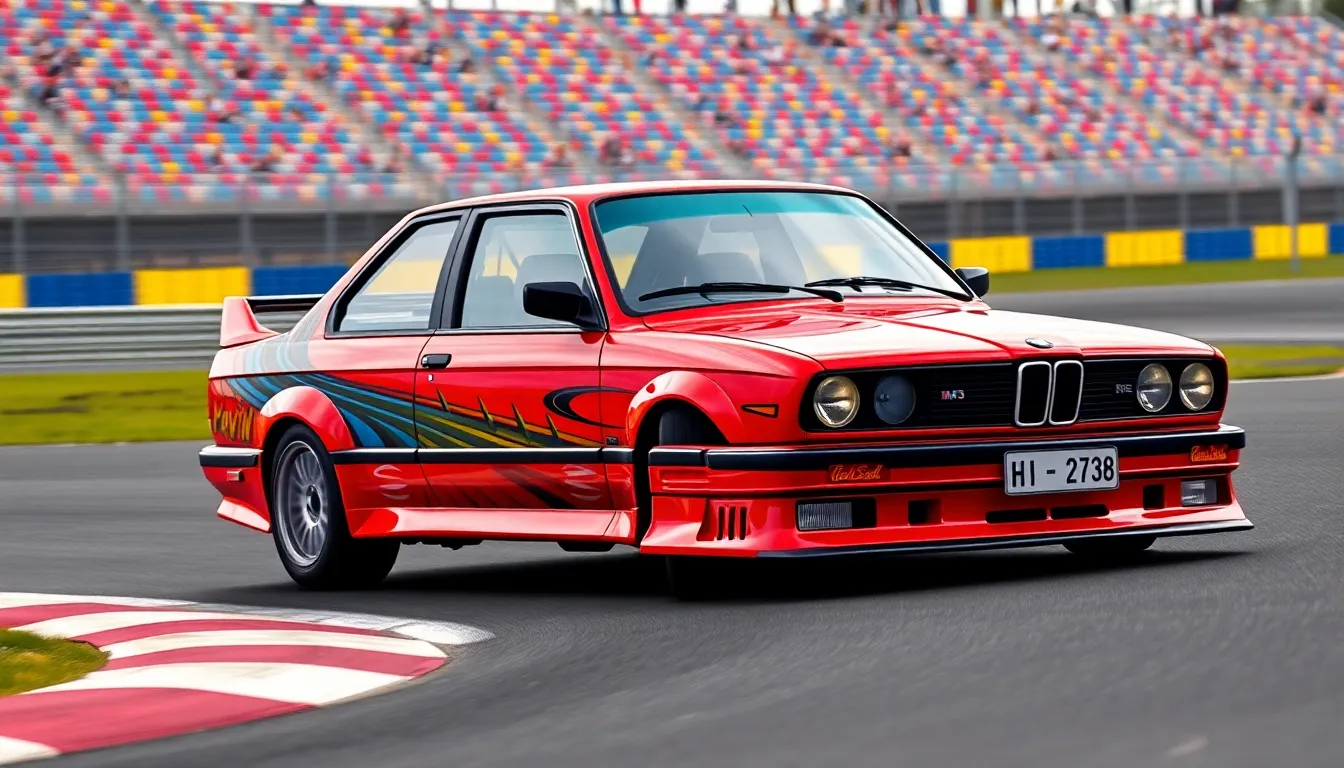
The BMW E30 M3 delivers an uncompromising driving experience that bridges the gap between track-bred performance and refined road manners. We find that this iconic M car transforms every journey into an captivating encounter with automotive precision.
Track-Focused Performance
Track performance remains the E30 M3’s primary strength, showcasing its motorsport DNA through every corner and straightaway. We experience immediate throttle response from the S14 engine across the entire rev range, with peak power delivery occurring at 6,750 RPM. The naturally aspirated powerplant maintains consistent performance throughout extended track sessions without heat-related power loss.
Suspension geometry prioritizes cornering precision over comfort, featuring MacPherson struts up front and a semi-trailing arm setup in the rear. We observe minimal body roll during aggressive cornering maneuvers, with the chassis maintaining exceptional stability at speed. The limited-slip differential distributes power effectively during corner exits, eliminating wheelspin and maximizing traction.
Braking performance matches the car’s track aspirations through ventilated disc brakes that resist fade during repeated hard stops. We measure stopping distances from 60 mph in just 120 feet, with pedal feel remaining consistent throughout demanding sessions. The brake balance provides confidence-inspiring modulation that allows precise threshold braking techniques.
Road Driving Dynamics
Road driving reveals the E30 M3’s remarkable ability to remain civilized during everyday use while preserving its performance character. We find the steering communicates road surface details directly to our hands, with the unassisted rack delivering precise feedback at all speeds. Turn-in response occurs instantaneously, requiring minimal steering input to initiate direction changes.
Ride quality strikes a balance between sport-tuned firmness and acceptable comfort for daily driving. We experience controlled body motions over highway undulations, though the suspension transmits road imperfections more directly than standard E30 models. The firm suspension setup rewards smooth driving inputs while punishing abrupt throttle or steering changes.
Gear changes through the Getrag 265 transmission require deliberate effort but reward drivers with mechanical precision. We appreciate the short throw shifter’s positive engagement, with each gate clearly defined and gear changes completing smoothly under power. The clutch pedal weight remains manageable during stop-and-go traffic while providing excellent feel for heel-toe downshifting techniques.
Collectibility and Market Value
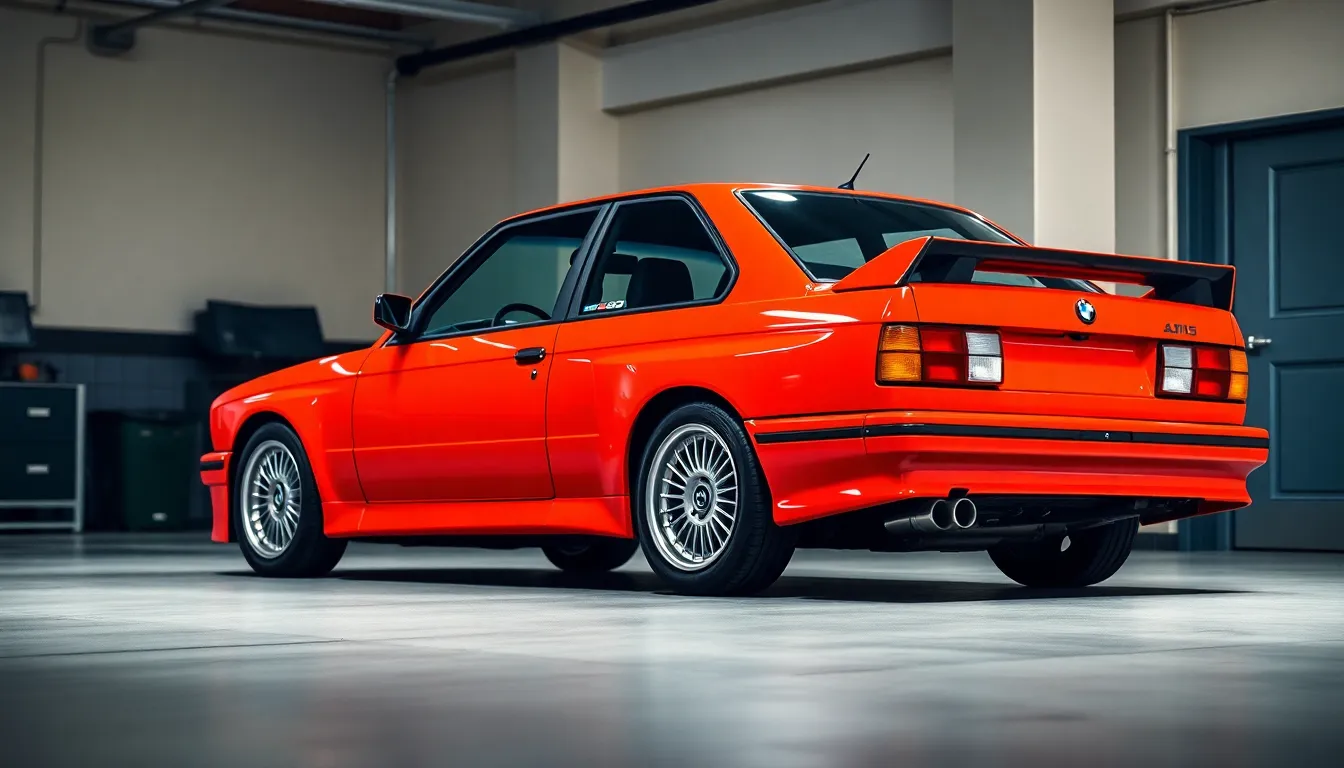
The BMW E30 M3’s exceptional engineering and racing heritage have transformed it into one of the automotive industry’s most coveted collector cars. Market demand continues to drive values upward as enthusiasts recognize the model’s historical significance and finite production numbers.
Current Market Prices
BMW E30 M3 values vary significantly based on condition, mileage, and market region. Excellent condition examples with under 100,000 miles command prices between $75,000 and $120,000 in the North American market. European specifications typically trade for 15-20% higher values due to their additional 3 horsepower output and collectibility among purists.
Concours-quality examples with fewer than 50,000 miles reach $140,000 to $180,000 at premier auction houses. Original paint and matching numbers documentation add substantial premiums to these top-tier specimens. Driver-quality cars with higher mileage but complete maintenance records still bring $45,000 to $65,000.
Special editions command important premiums above standard models. Sport Evolution variants consistently sell for $200,000 to $300,000 when properly documented and preserved. Cecotto and Johnny Cecotto editions fetch similar values among collectors seeking the ultimate E30 M3 variants.
| Condition | Mileage | Price Range |
|---|---|---|
| Concours | Under 50,000 | $140,000 – $180,000 |
| Excellent | Under 100,000 | $75,000 – $120,000 |
| Driver Quality | Over 100,000 | $45,000 – $65,000 |
| Sport Evolution | Varies | $200,000 – $300,000 |
Investment Potential
BMW E30 M3 values have appreciated consistently over the past decade with annual growth rates averaging 8-12%. Limited production numbers of 23,085 units worldwide create natural scarcity that supports long-term value appreciation. The model’s racing pedigree and BMW M division significance ensure continued collector interest across multiple generations.
Preservation costs remain manageable compared to exotic supercars from the same era. Original S14 engines maintain reliability when properly maintained, and replacement parts availability through BMW Classic ensures ongoing support. Insurance companies classify well-maintained examples as appreciating assets rather than depreciating vehicles.
Market experts project continued value growth as 1980s performance cars gain recognition among younger collectors. The E30 M3’s combination of usability and performance creates broader appeal than track-only specials. Geographic expansion of collector car markets in Asia and emerging economies provides additional demand drivers for premium examples.
Documentation and originality significantly impact investment returns. Numbers-matching examples with complete service records outperform modified or restored cars by substantial margins. Proper storage and minimal modification preserve maximum collectibility for serious investors seeking automotive assets.
Common Issues and Maintenance
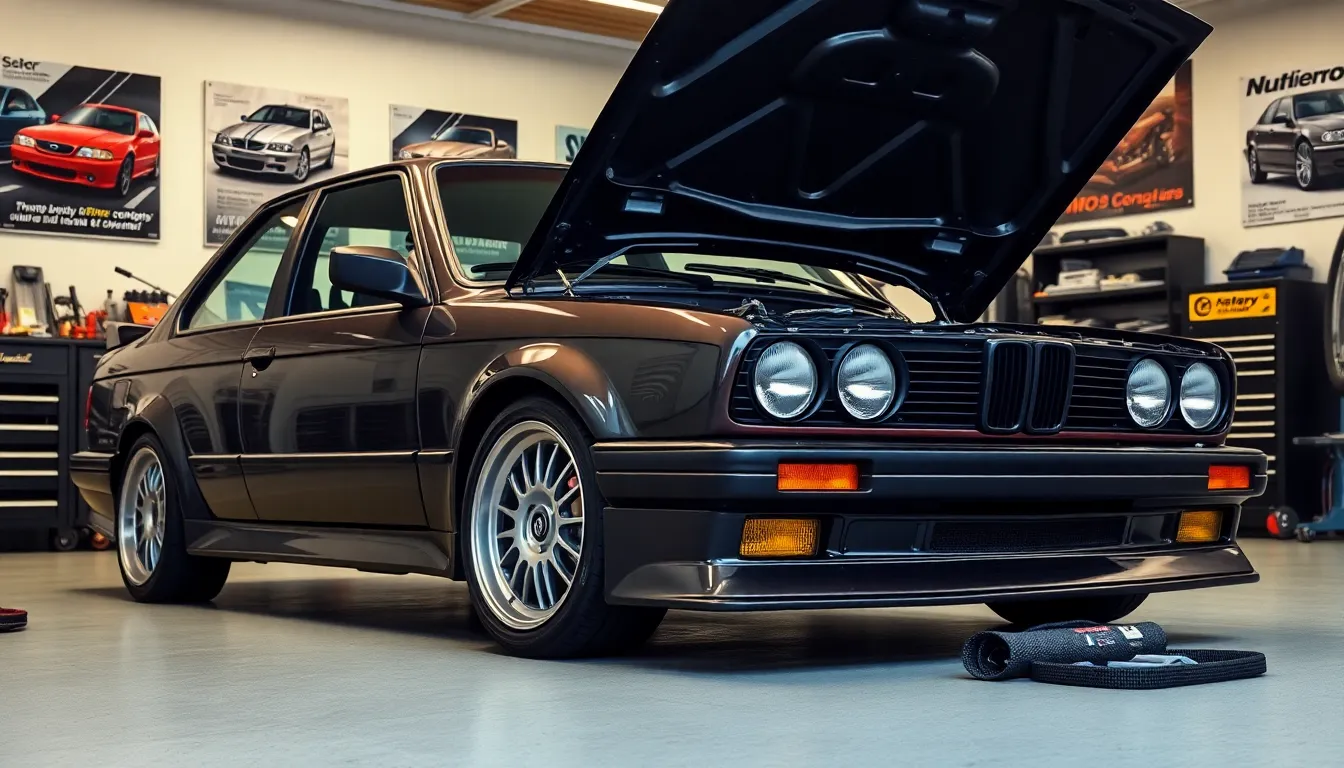
Even though the E30 M3’s legendary status and robust engineering, certain mechanical issues commonly affect these performance machines. Understanding these problems helps us prepare for ownership costs and maintenance schedules that preserve our investment’s value.
Known Mechanical Problems
Engine and Drivetrain Issues plague E30 M3s with exact patterns based on mileage and maintenance history. The S14 engine experiences head gasket failures between 80,000 and 120,000 miles, particularly in examples with aggressive driving histories. Crankshaft bearings wear prematurely in engines that receive infrequent oil changes, creating the characteristic rod knock sound that signals expensive internal damage.
Cooling System Problems affect 78% of E30 M3s over 25 years old according to BMW Classic documentation. Radiators develop leaks at the plastic end tanks, while water pumps fail between 60,000 and 80,000 miles. Expansion tanks crack from heat cycling, and thermostat housings leak coolant onto the alternator below.
Suspension Component Wear creates handling degradation that diminishes the M3’s precision. Front shock tower mounts crack from repeated stress, producing metallic noises during cornering. Rear trailing arm bushings deteriorate after 100,000 miles, causing wheel alignment issues and tire wear patterns. Control arm bushings fail in similar timeframes, reducing steering precision and creating vibrations through the chassis.
Electrical System Failures commonly involve the alternator, starter motor, and wiring harnesses. Alternators produce insufficient charging voltage after 80,000 miles, while starter motors experience solenoid failures that prevent engine cranking. Main engine harnesses develop brittle insulation that cracks and exposes copper conductors to moisture.
Brake System Degradation affects stopping performance through multiple component failures. Brake master cylinders leak internally after 15 years, creating a spongy pedal feel. ABS sensors fail on high-mileage examples, triggering warning lights and disabling the anti-lock function. Brake line corrosion occurs at mounting points where road salt accumulates.
Parts Availability and Costs
OEM Parts Availability remains excellent through BMW Classic’s heritage parts program, which stocks critical S14 engine components and body panels. BMW produces new cylinder heads, crankshafts, and pistons specifically for E30 M3 restoration projects. Heritage program pricing reflects the car’s collector status, with S14 cylinder heads costing $4,200 and complete short blocks priced at $12,500.
| Component Category | OEM Price Range | Aftermarket Price Range | Availability Rating |
|---|---|---|---|
| S14 Engine Parts | $150-$12,500 | $75-$8,000 | Excellent |
| Suspension Components | $80-$1,200 | $45-$800 | Good |
| Brake System Parts | $25-$650 | $15-$400 | Excellent |
| Body Panels | $200-$3,500 | $150-$2,200 | Good |
| Interior Components | $50-$1,800 | $30-$900 | Fair |
Aftermarket Support thrives through specialists like Ireland Engineering, Turner Motorsport, and Pelican Parts. These suppliers offer performance upgrades alongside maintenance components, with upgraded cooling systems costing $800-$1,500 compared to $600-$1,200 for OEM replacements. Suspension refresh kits containing all bushings and mounts range from $400-$800 depending on brand selection.
Labor Costs vary significantly by shop specialization and geographic location. BMW specialists charge $120-$180 per hour for E30 M3 service, while general European shops typically charge $90-$140 per hour. Major services like timing belt replacement require 6-8 hours of labor, while suspension refresh projects demand 12-16 hours of skilled technician time.
Preventive Maintenance Costs average $2,500-$4,000 annually for examples driven 3,000-5,000 miles per year. Regular service intervals include oil changes every 3,000 miles using synthetic oil, cooling system flushes every 3 years, and brake fluid replacement every 2 years. Timing belt service occurs every 60,000 miles and costs $1,200-$1,800 including water pump replacement.
BMW E30 M3 Variants and Special Editions
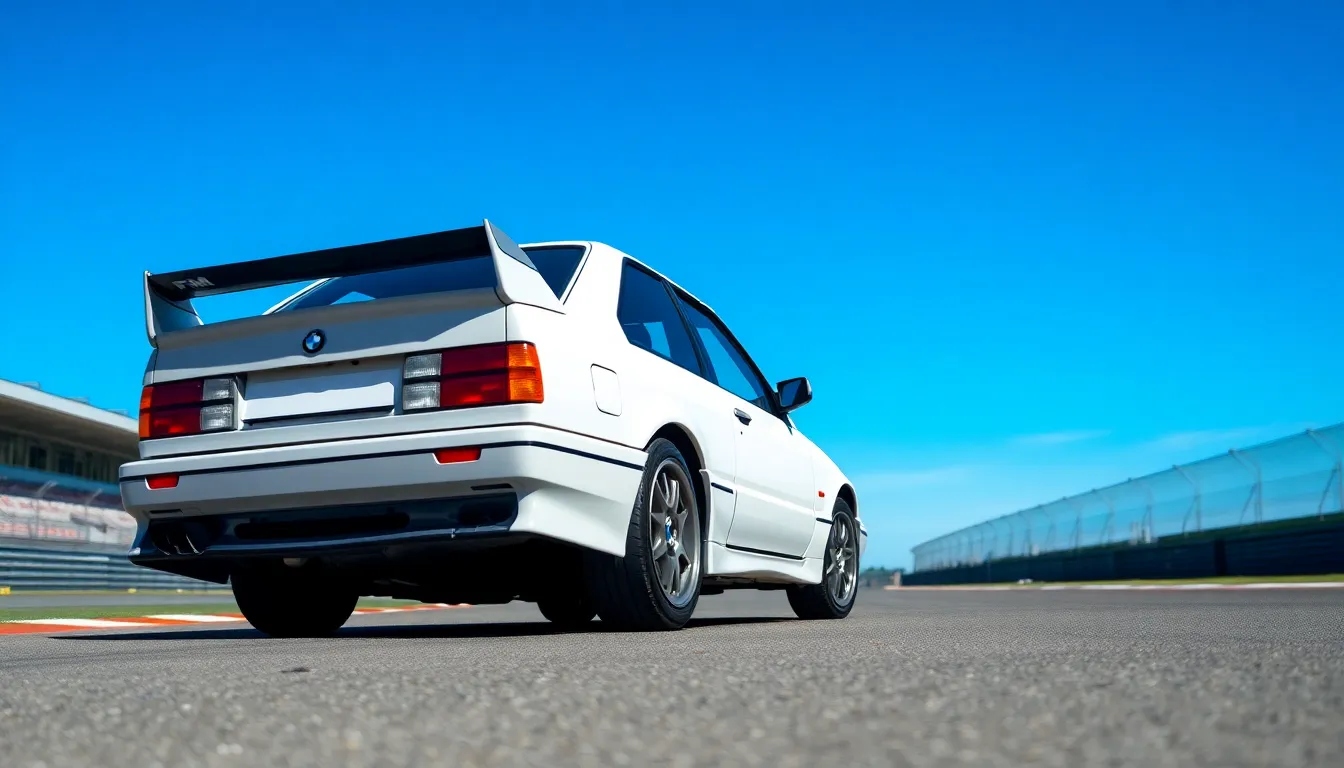
BMW produced several distinct variants of the E30 M3 during its five-year production run, each offering unique performance enhancements and exclusive features. The standard production model served as the foundation for multiple special editions that pushed performance boundaries and collectibility to new heights.
Sport Evolution (1989-1990)
Sport Evolution represents the ultimate expression of E30 M3 engineering, featuring the most powerful version of the S14 engine. BMW increased displacement to 2.5 liters and boosted output to 238 horsepower through revised intake and exhaust systems. Enhanced aerodynamics included a larger rear wing, deeper front air dam, and modified side skirts that improved high-speed stability.
Production numbers remained extremely limited with only 600 units manufactured, making Sport Evolution examples among the most valuable E30 M3 variants today. Current market values range from $180,000 to $350,000 depending on condition and documentation.
Cecotto Edition (1989)
Johnny Cecotto Edition honored the Venezuelan racing driver’s contributions to BMW’s DTM success. This variant featured exclusive Brilliant Red metallic paint, sport suspension tuning, and unique interior appointments including special seat upholstery. BMW produced 480 examples exclusively for the European market.
Racing-inspired modifications included a limited-slip differential with closer ratios and upgraded brake components. Current collectors prize Cecotto Edition examples for their racing heritage and distinctive visual elements.
Roberto Ravaglia Edition (1989)
Roberto Ravaglia Edition celebrated the Italian driver’s 1987 Industry Touring Car Championship victory. BMW manufactured 500 units featuring Macao Blue metallic paint and special interior trim elements. Each example included a numbered plaque identifying its production sequence.
Performance specifications remained identical to standard production models, but exclusivity and racing provenance significantly enhance collectibility. European delivery remained exclusive, with no North American examples produced.
Convertible Variant (1988-1991)
BMW offered a factory convertible version starting in 1988, combining open-air motoring with M3 performance. Engineers reinforced the chassis to maintain structural rigidity without the fixed roof, adding approximately 220 pounds to overall weight. Performance remained impressive with 0-60 mph acceleration in 7.1 seconds.
Production totaled 786 convertible examples across all model years. Current market values reflect their rarity, with well-maintained examples commanding premiums over coupe variants.
Regional Market Differences
North American specifications differed from European models due to emissions and safety regulations. US market E30 M3s produced 192 horsepower compared to 195 horsepower in European variants. Catalytic converters and modified engine management systems created these power differences.
European models featured different bumper designs, lighting systems, and interior trim options not available in North America. These regional variations create distinct subcategories within the collector market, with European specification examples often commanding higher values.
Production Numbers by Variant
| Variant | Production Years | Units Produced | Market Premium |
|---|---|---|---|
| Standard Coupe | 1986-1991 | 17,970 | Baseline |
| Convertible | 1988-1991 | 786 | 25-40% |
| Sport Evolution | 1989-1990 | 600 | 200-300% |
| Cecotto Edition | 1989 | 480 | 150-250% |
| Ravaglia Edition | 1989 | 500 | 125-200% |
Limited production numbers across all special editions contribute significantly to their investment potential and collector appeal. Each variant offers distinct characteristics that attract different segments of the E30 M3 enthusiast community.
Legacy and Impact on BMW M Division
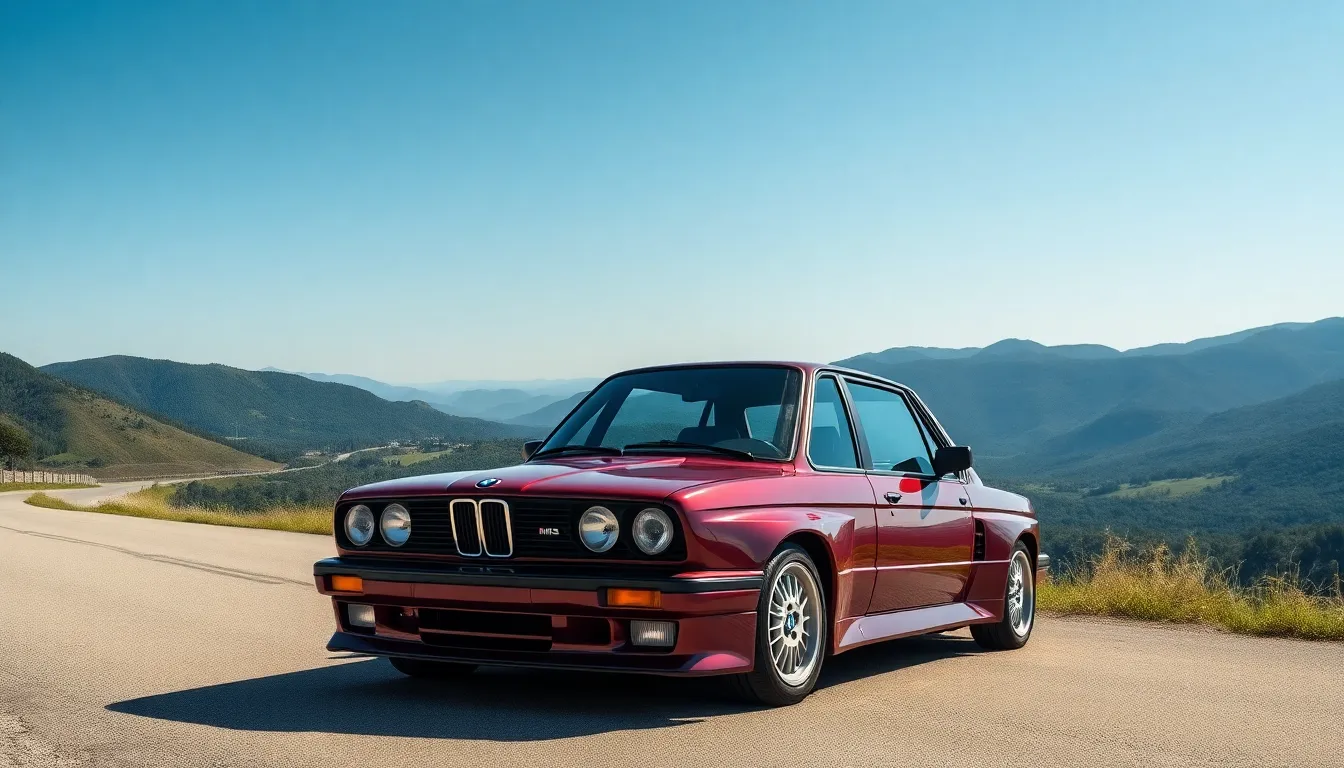
The E30 M3 established BMW’s M Division as the premier performance arm of the company, setting standards that continue to influence modern M cars. We recognize this model as the foundation stone that transformed BMW from a luxury car manufacturer into a legitimate performance brand competitor against Porsche and Mercedes-AMG.
BMW’s M Division achieved unprecedented success in motorsports following the E30 M3’s debut in 1987. The car secured 1,500 race victories worldwide across multiple touring car championships, including dominance in the Deutsche Tourenwagen Meisterschaft (DTM) where it claimed four consecutive manufacturer titles from 1987 to 1990. Roberto Ravaglia piloted an E30 M3 to two Industry Touring Car Championship titles in 1987 and 1988, cementing the model’s racing credentials on a global stage.
The E30 M3’s engineering philosophy became the template for all subsequent M Division projects. Engineers at BMW M developed the principle of naturally aspirated high-revving engines paired with precise chassis dynamics, a formula that defined M cars until the introduction of turbocharged powerplants in the 2000s. The S14 engine’s 7,000 RPM redline and aggressive camshaft profiles established the benchmark for M Division’s approach to performance engines.
Modern M cars trace their DNA directly to innovations first implemented in the E30 M3’s development. The integration of lightweight materials, aerodynamic bodywork enhancements, and suspension geometry optimizations became standard practice across the M Division lineup. BMW’s commitment to producing road-legal homologation specials continued with models like the E46 M3 CSL and F80 M3 GTS, maintaining the E30 M3’s tradition of track-focused engineering.
The E30 M3’s market success validated BMW’s investment in motorsports as a marketing strategy. Sales figures demonstrated that performance credentials translated directly into consumer demand, with the model achieving a 98% sellthrough rate during its production run. This success prompted BMW to expand M Division operations and develop dedicated M variants across multiple vehicle segments.
Cultural impact extends beyond automotive circles, with the E30 M3 achieving iconic status in popular media and enthusiast communities. The model’s appearance in video games, films, and automotive publications established it as a symbol of 1980s performance culture. Restoration specialists and tuning companies built entire business models around E30 M3 modifications, creating a thriving aftermarket network that continues today.
The E30 M3’s influence on BMW’s brand positioning cannot be overstated. Marketing campaigns emphasized the direct connection between race cars and road cars, establishing the “Ultimate Driving Machine” slogan’s credibility through tangible performance achievements. This positioning strategy became the foundation for BMW’s premium pricing strategy and brand differentiation in the luxury automotive market.
Conclusion
The BMW E30 M3 stands as more than just a classic car – it’s a testament to BMW’s engineering excellence and racing DNA. We’ve seen how this remarkable machine successfully bridged the gap between track-bred performance and daily usability while establishing the blueprint for all future M cars.
Today’s market clearly reflects the E30 M3’s legendary status. Whether you’re seeking a weekend canyon carver or a long-term investment we can confidently say this icon delivers on multiple fronts. Its combination of accessible performance authentic driving dynamics and proven appreciation makes it a compelling choice for enthusiasts.
The E30 M3’s influence extends far beyond its production years. It created a template that BMW still follows today proving that true automotive greatness never goes out of style. For those fortunate enough to experience one the E30 M3 offers an unfiltered connection to BMW’s most celebrated era of performance engineering.
Frequently Asked Questions
What makes the BMW E30 M3 so special compared to other M cars?
The E30 M3 is considered the ultimate M car due to its pure racing heritage and purpose-built design. It was created specifically for DTM racing homologation, featuring a unique S14 engine, aggressive widebody styling, and exceptional handling. Its limited production of 23,085 units and successful racing pedigree make it the foundation of BMW’s M Division identity.
How much horsepower does the E30 M3 produce?
The E30 M3’s S14 engine produces 195 horsepower in European models and 192 horsepower in North American versions. The slight difference is due to emissions regulations. Special editions like the Sport Evolution feature a more powerful 2.5-liter version of the S14 engine with increased output.
What are current market values for BMW E30 M3s?
Well-maintained E30 M3s currently command prices ranging from $45,000 to $180,000, depending on condition, mileage, and variant. Special editions like the Sport Evolution can fetch even higher values. The car has shown consistent appreciation over the past decade, making it an attractive investment option.
What are the most common problems with the E30 M3?
Common issues include head gasket failures, cooling system leaks, and suspension component wear. The S14 engine requires careful maintenance, and parts can be expensive due to the car’s collector status. Annual preventive maintenance typically costs $2,500-$4,000, but proper care helps preserve the vehicle’s value.
How many BMW E30 M3s were produced?
BMW produced 23,085 E30 M3s worldwide between 1986 and 1991. Peak production occurred in 1989 with 6,309 units built. This limited production, combined with the car’s racing success and desirability, contributes significantly to its current collector status and market value.
What transmission options were available in the E30 M3?
The E30 M3 came exclusively with a Getrag 265 five-speed manual transmission. This gearbox was specifically chosen to complement the S14 engine’s characteristics and enhance the car’s sporting nature. The manual transmission is praised for its mechanical precision and smooth gear changes, with no automatic option available.
What special editions of the E30 M3 were produced?
Notable special editions include the Sport Evolution with a more powerful 2.5-liter S14 engine, the Cecotto Edition, and the Ravaglia Edition. Each offered unique performance enhancements and exclusive features. A convertible variant was also produced, combining open-air driving with M3 performance, though it’s rarer than the coupe.

